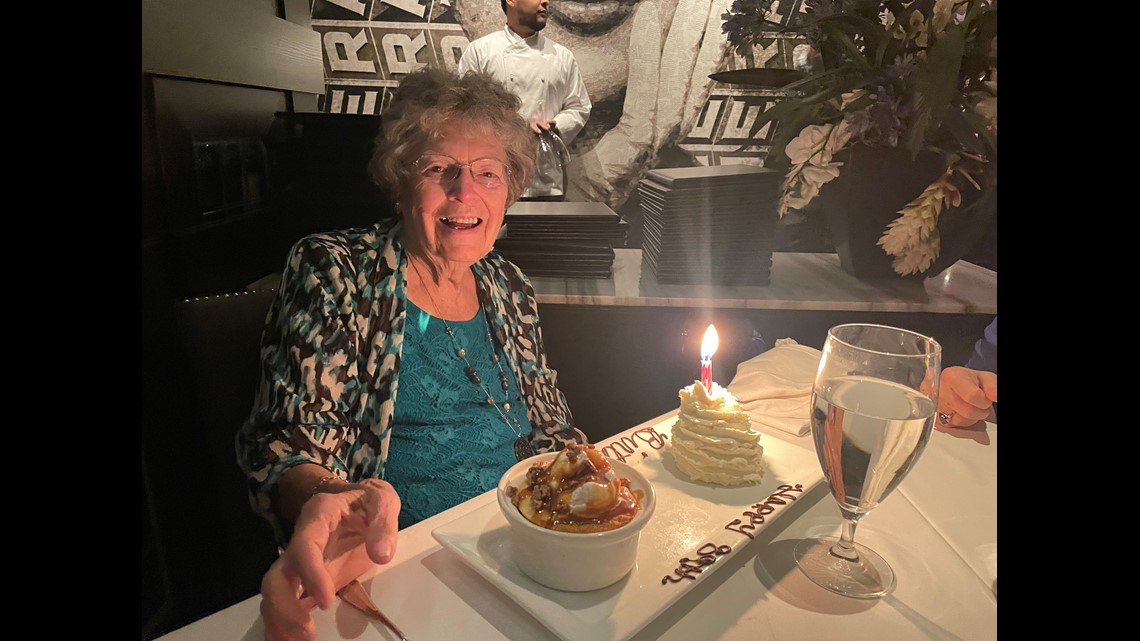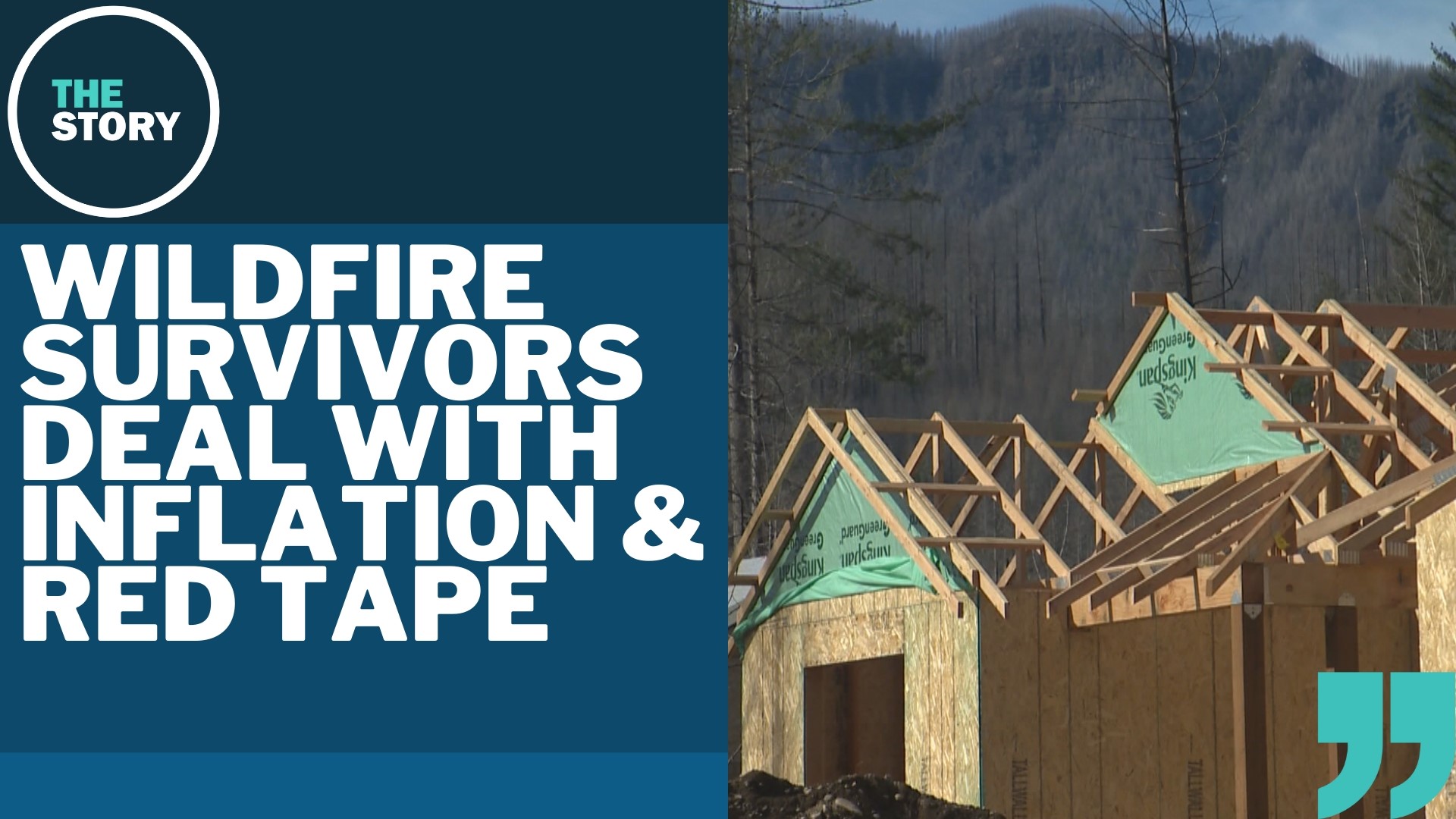MILL CITY, Ore. — Building new housing for wildfire survivors has been a slow and frustrating process for many people who are trying to move forward from the devastating Labor Day wildfires of 2020. The fires burned a million acres and more than 4,000 homes across Oregon.
A number of wildfire survivors are now dealing with red tape and bureaucratic delays, keeping the process moving at a snail’s pace. Now, with inflation, building costs have shot up, making the process even slower.
It’s been nearly two years since Lucretia Benolken lived on her property along the North Fork River in the Santiam Canyon. She remembers her neighbors coming to her door, waking her up, and telling her she had to leave.
“They came in and said you have five minutes to get ready. We’re leaving. The fire’s on its way here,” recalled Benolken.
Days later, she found out she had lost everything from her home, to her woodworking shop and her car.
“It was pretty scary. Realizing that I had nothing left but the clothes on my back and my medicine. I had that with me, and that was it,” Benolken said.
Benolken, who is 89, is now living in Arizona at her daughter's second home as she waits for her new home to be rebuilt. She said she’s fortunate her son is her contractor, but the process is taking a while.
“Insurance doesn't cover everything and all the materials have gone sky high as far as the price,” she said.
Benolken is one of the many people who are still displaced and waiting for a home.
“Given that we were already in a housing crisis, and what has happened with construction cost escalation, that really drove us to spending every dollar that we that we could justify on housing,” said Alex Campbell, the external affairs officer for the disaster recovery and resilience section of Oregon Housing and Community Services.
Oregon Housing and Community Services is the state agency responsible for distributing $422 million of wildfire disaster recovery money from the federal government. The OHCS program doing that is called ReOregon.
“We dedicated over $300 million of that $422 [million] to housing programs. The majority of that for folks who lost a home,” Campbell said.
He said the idea is to provide affordable housing to people in the form of home ownership for both prior homeowners and those who rented before and want to buy. Campbell anticipates wildfire survivors will be able to apply late this year or early next year.
According to Campbell, new homes likely won’t be available until the end of next summer.
In the McKenzie River Valley where the Holiday Farm Fire burned, Jamee Savidge said she believes housing is the community’s biggest issue.
Savidge works for Cascade Relief Team, a nonprofit helping with wildfire recovery.
“My main concern is the 150 families that are on their property living in an RV, some with two, three, four or five kids that are trying to figure out what their rebuild is going to look like and how they're going to do it,” Savidge said.
She said the $422 million in federal grant money will mostly help those with the least resources, which is needed, but she’s also worried about all the people who were underinsured.
“It's the people that are in the middle, that [had] good employment and you know, solid income and solid credit history. Those are the people that are having the most difficult time right now,” said Savidge.
Campbell said Oregon Community Housing and Services is required by the federal government to spend 70% of the total grant to benefit “low and moderate income individuals.”
In Marion County, Commissioner Danielle Bethell said about 300 families still don’t have a place to call home. She says while there are big plans to build more rental units but due to inflation and rising costs, things are moving slowly.
“The county is still working on two projects, temporary housing projects, which are tiny homes, 16 units in Gates at the old Gates Motel site and 16 units at North Santiam State Park. Both of those projects are taking much longer than anticipated,” said Bethell.
She said the Gates project will likely be complete this year by early winter. The housing project at North Santiam State Park will take longer, but may be open by next spring. It’s under environmental review right now.
She said the LIFT project in Mill City will offer 54 units of affordable multifamily housing. Bethell said developers are moving ahead but it’s also a pretty slow process.
Among the hurdles there, Bethell said developers have to work around the Mill City sewer system which lacks capacity. She said the system needs improvements and the hope is that groundbreaking can happen in 2023.
Additionally, Bethell said the county has bought 14 acres of land in Mill City to develop more affordable housing. That effort is part of more than $73 million that Oregon Housing and Community Services has given out to fund over 600 affordable homes. The $73 million is separate from the federal grant.
Campbell said the Oregon legislature allocated more than $150 million to help wildfire recovery efforts in the state.
Meantime, Benolken is hopeful she’ll be able to move back into her new home this summer. She recently received a grant from a local organization to help with her home build. It doesn’t pay for everything, but she’s grateful for all the support she has.
“[I’m] thankful for the people and the friends that I’ve have that have been so very helpful and thoughtful,” said Benolken.


Benolken’s family has also started a GoFundMe to help pay for rebuilding and furnishing her home.
While most of the $422 million in federal grant money will be going toward affordable housing, some of it will also be used for things like infrastructure, mitigating future fires and disasters, and economic revitalization. But Campbell said unfortunately, while $422 million may sound like a lot to many people, it isn’t enough to address all the wildfire-related needs in Oregon.
Campbell also said there are programs available right now to help people with rebuilding if they are low and moderate income. People who are low or moderate income and were impacted by the 2020 wildfires can get a disaster case manager to help them by calling this hotline: 833-669-0554.
Aside from that, there are a number of resources that can help with housing-related concerns. There are also local groups, like the Santiam Canyon Wildfire Relief Fund, trying to help people in specific areas.
Here is a list of housing resources by county from the Oregon Housing and Community Services:
Clackamas County
Catholic Charities: 503-688-2694
www.catholiccharitiesoregon.org/services/disaster-services
Douglas County
UCAN: 541-802-6529
www.ucancap.org
Jackson County
ACCESS Center for Community Resilience: 541-414-0318
www.accesshelps.org/ccr
Klamath County
Klamath-Lake Community Action Services: 541-882-3500
www.klcas.org
Lane County
Oregon Department of Human Services: 971-388-9081 (DHS)
www.oregon.gov/dhs/EmergencyManagement/Pages/wildfires.aspx
Lincoln or Linn County
Community Services Consortium: 458-239-2265
communityservices.us
Marion County
Mid-Willamette Valley Community Action Agency: 503-399-9080 (Press 6)
mwvcaa.org

